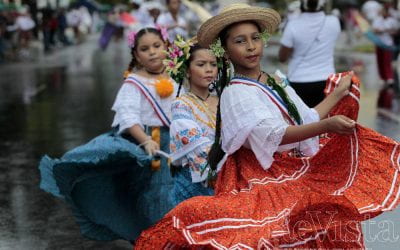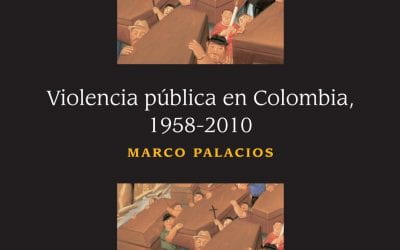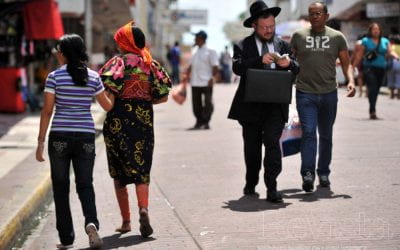Degreening Panamá
Growth and Environment
Panamá is in the news. Although it’s a small country of only 75,000 square kilometers, it’s a place where many want to invest, do business, work and live. The reason: an astonishing economic growth rate that reached 10 percent in the second trimester of 2012. And that’s in the midst of an economic crisis across almost the entire planet.
At the same time that Panamá’s economy is expanding, its natural resources are being attacked relentlessly. Yet the economic value of the country’s rich biodiversity, under threat from this continued exploitation of natural resources, is thus far unknown.
The assault on Panamá’s natural environment began in the 1990s, with the construction of infrastructure megaprojects such as the northern and southern expressways leading into Panama City. It didn’t matter that the megaprojects cut through parks, isolated animal and bird species, dried up rivers or destroyed forests. Under the current administration of President Ricardo Martinelli, systematic and relentless destruction of natural resources has reached unprecedented levels.
Panamá’s geographical location—albeit in one of the most biodiverse regions of the planet—has determined its local economic model. From the historic Camino de Cruces, along which the Spanish colonial powers sent all the wealth to Europe after having extracted it from the earth starting in the 15th century, to the railroad of the “gold rush years,” and finally to the interoceanic canal now undergoing a major expansion, the country’s location had ever determined its economy, which currently focuses on financial services and international transport of merchandise. The concept of sustainable development seems to be a mystery to the country’s main economic actors.
At present, with the expansion of the Panama Canal advancing full steam ahead, the entire country seems to be under major construction. Projects range from state-sponsored infrastructure such as the Panama City metro, highways, hospitals, airports and markets to private investments such as unsystematic, runaway building of residential and hotel projects, the construction of hydroelectric plants and numerous open pit mining projects.
Both local and international market forces have found a strong ally—an accomplice even—in the present government. The system of resource protection initiated with the 1998 General Environmental Law and the creation of the National Environmental Authority (known by its Spanish acronym as ANAM), has effectively been dismantled.
The only exception is the canal. Shielded from political whims by constitutional mechanisms and a culture that values professional merit, the administration of the waterway maintains a program of protection of water sources for an obvious reason: if there is no water, the canal does not function. However, not everything is rose-colored in terms of the canal: the deforestation and pollution that affect the rest of the country are steadily advancing in its direction.
THREATENED BIODIVERSITY
Panamá is a paradise of biodiversity; it is no coincidence that the Smithsonian Institute for Tropical Investigations has flourished here since 1910. Generations of scientists from around the world have come to Panamá to study its rich and varied wildlife.
According to ANAM’s most recent National Report on Biodiversity (Informe Nacional de Biodiversidad 2010), Panamá ranks 28th worldwide in terms of biological diversity—and 10th in the world in relation to its size— with more vertebrate animals than anywhere else in Central America or the Caribbean and a greater number of bird species than in the United States and Canada combined. As surprising as it sounds, Panamá has 21 times more plant species per square kilometer than Brazil.
The other side of the coin is the grave problem of erosion and deterioration of soil. According to the United Nations Environment Programme (UNEP), Panamá’s soil is one of the most degraded in Latin America. Moreover, almost all of its water sources have problems of sedimentation and pollution, severely affecting the productive capacity of its regions. In Panamá, the earth is producing less and less.
Another tragedy is the irreparable process of the destruction of forests. Some 175,000 acres of the 19 million that make up the Panamanian territory are deforested every year, producing a chain of destruction that includes unique species of plants and animals.
Among the most affected species are mangroves, in areas that are highly coveted by developers for marinas, ports, golf courses and seaside hotels. Although Panamá signed the Ramsar Convention on Wetlands in 1989 and hosts five spots categorized as “wetlands of international importance” (the Panama Bay; the Gulf of Montijo in Veraguas Province; San San Pond Sak in Bocas del Toro Province; Patiño Point in Darién Province and Damani Guariviria in the Gnobe Bugle region), their present status is quite critical. In the last 40 years, more than half the mangrove swamps have been destroyed, particularly along the Pacific Coast.
The Martinelli government, it seems, respects no legal protection. If a law has to be changed, it is changed. If it is necessary to suspend a protection guaranteed by law, the Supreme Court of Justice is utilized to make the change. And this legislative bulldozing has direct, negative effects on Panamá’s natural resources.
Take the example of fishing. Legislative changes and regulations about it as enacted by the Panamanian Water Resources Authority have had a dire effect on coastal marine resources. Fishing yields suffered a 20.7 percent decline in the second trimester of 2012 and 22 percent in the first half of the year.
DESTRUCTIVE DEVELOPMENT
While fishing and agricultural production are in decline in Panamá, gold and copper mining is on the rise. Gold has been Panamá’s number one export item since 2011, when large-scale open pit mining began, in the heart of Mesoamerica’s corridor of biodiversity. Panamá’s Chamber of Mining is forcefully promoting extractive activity in twelve gold and copper sites without taking into account the ensuing environmental problems.
Mining has already provoked social conflicts, especially in the indigenous areas in the eastern part of Chiriquí province, which has the largest unexploited copper deposit in the world. Mining this area would cause irreversible damage to the zone’s lands and rivers, directly affecting more than 160,000 Gnobe indigenous peoples, and infringing on the Coiba National Park, which had been declared Patrimony of Humanity by UNESCO.
In Panamá’s central region, a mining project threatens the headwaters of the rivers and springs for more than 230,000 inhabitants of the region—a heavily agricultural one where water sources already show high levels of sediments and contamination from pesticides and agrochemical products.
Energy generation is another source of grave socio-environmental conflict. The energy market, like those in many other countries in Latin America, has been opened to private companies. The state offers water concessions for the generation of electricity without planning, thus failing to protect the basins and ignoring the water needs of the general population, let alone the huge demand in the agricultural or tourism sectors. Almost all the waterways are designated for the production of electric energy.
Panamá provides a clear case of the disproportional exploitation of a natural resource. Bocas del Toro, one of the poorest provinces in the country, produces 42 percent of Panamá’s energy, while its population consumes less than 1 percent. Panama City, home to around 30 percent of Panamá’s population, consumes more than 60 percent of the energy generated in the country, without any norms to regulate consumption, stimulate efficiency or reduce waste.
Buildings on the beach demand around-the-clock air conditioning to avoid physical deterioration; at the same time, regulations that encourage energy-efficient designs are lacking. Eventually, their excessive energy consumption ends up taxing rural communities and their natural resources.
Panama City—and in reality the entire country—is growing rapidly without bounds or clear norms. The market, with the famous building boom and accompanying speculation, establishes the parameters—or lack thereof. Land use change—the most important cause of emissions of CO2 in Latin America—creates the constant loss of green zones, public spaces and urban forests in the metropolitan area. Without active and determined citizen participation, this urban malaise cannot be stopped.
In addition, Panamá still lacks a policy on climate change that will help us adapt to the changes in temperature, soil and weather patterns. We simply deal with these changes when there is a crisis and don’t think about how they could be prevented or prepared for.
The consequences of ecosystem destruction, added to the lack of preventive measures in the face of increasingly intense rains, are more serious every year. At the end of last November, floods exacerbated by the destruction of mangroves and construction in vulnerable areas left 5,000 people displaced and several dead, with substantial economic damage to the city of Colón and areas west of the capital. Water swept away everything in its path.
The environmental picture could be improved with the reinstatement of the ANAM, along with the ecological policies developed during several previous Panamanian administrations. Panamá needs a serious and coherent environmental policy in keeping with the vulnerability and richness of our environment.
Panamá has the potential to be a regional model of environmental sustainability because of its great natural resources, its geographic location and the strength of its service sector. But it must strengthen clean industries and reject those which abuse its natural resources and leave serious environmental externalities. Panamá must realize that the economy of a nation should always take environmental effects into account.
Spring 2013, Volume XII, Number 3
Lina Vega Abad is a lawyer and journalist. She has worked at La Prensa de Panamá since 1999, where she has served as an editor of various sections, including opinion, city, politics, news and the investigative unit. She is presently a columnist and coordinator of a Citizen Journalism program. She founded the Center for Environmental Impact and is now a member of its board. She was the former director of the Panamanian chapter of Transparency International.
Raisa G. Banfield is an architect and an environmental activist. She hosts a weekly television show Cuidando El Planeta 3 (Taking Care of the Planet 3). Founding director of the Center for Environmental Impact, she presently directs the organization Panamá Sostenible (Sustainable Panamá) to promote alternatives to practices that damage the environment.
Related Articles
Panamá and the United States
Marching bands in their colorful uniforms from schools all over Panamá fill the streets of the City for the November 3 Independence Day parades. Panamá is…
Violencia pública en Colombia
Another book about violence in Colombia? At first glance, it would seem superfluous to add one more title to the already extensive bibliography that…
Muslims and Jews in Panamá
The Muslim community in Panamá, understood as a group that maintains its cultural and religious traditions, became rooted in the second half of the 20th…





